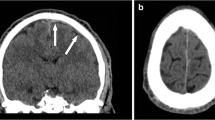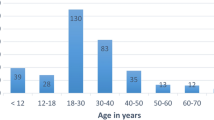Abstract
Introduction
The benefits of multiplanar reconstructed images (MPR) of unenhanced axial head computed tomography (CT) data have not been established in trauma patients younger than 3 years old, a population in which a reliable history and physical examination may be most difficult. We retrospectively evaluated unenhanced head CTs in pediatric trauma patients to investigate the various benefits of MPR in this age group.
Methods
A total of 221 unenhanced head CTs performed for any case of head trauma (HT) on children younger than 3 years old were independently reviewed by two radiologists. Studies were reviewed first in the standard axial plane alone and then with the addition of MPR. Reviewers were asked to determine if the MPR affected the ability to make findings of hemorrhage, incidental findings, and artifacts.
Results
MPR improved the detection of hemorrhage in 14 cases (6.5 %, p-value < 0.01) and incidental findings in five cases (2.3 %, p-value < 0.05) as well as helped prove artifacts in five cases (2.3 %, p-value < 0.05).
Conclusion
Routine use of MPR in HT patients younger than 3 years old has the potential to increase the detection of acute and incidental imaging findings.







Similar content being viewed by others
References
Marin JR, Weaver MD, Yealy DM, Mannix RC (2014) Trends in visits for traumatic brain injury to emergency departments in the United States. JAMA 311(18):1917–1919. doi:10.1001/jama.2014.3979
Wei SC, Ulmer S, Lev MH, Pomerantz SR, González RG, Henson JW (2010) Value of coronal reformations in the CT evaluation of acute head trauma. AJNR Am J Neuroradiol 31(2):334–339. doi:10.3174/ajnr.A1824
Zacharia TT, Nguyen DT (2010) Subtle pathology detection with multidetector row coronal and sagittal CT reformations in acute head trauma. Emerg Radiol 17(2):97–102. doi:10.1007/s10140-009-0842-6
Ortega HW, Vander Velden H, Reid S (2012) Incidental findings on computed tomography scans in children with mild head trauma. Clin Pediatr 51(9):872–876. doi:10.1177/0009922812450508
Vorona GA, Zuccoli G, Sutcavage T, Clayton BL, Ceschin RC, Panigrahy A (2013) The use of adaptive statistical iterative reconstruction in pediatric head CT: a feasibility study. AJNR Am J Neuroradiol 34(1):205–211. doi:10.3174/ajnr.A3122
Margulies SS, Thibault KL (2000) Infant skull and suture properties: measurements and implications for mechanisms of pediatric brain injury. J Biomech Eng 122(4):364–371
Feldman KW, Bethel R, Shugerman RP, Grossman DC, Grady MS, Ellenbogen RG (2001) The cause of infant and toddler subdural hemorrhage: a prospective study. Pediatrics 108(3):636–646
Thibault KL, Margulies SS (1998) Age-dependent material properties of the porcine cerebrum: effect on pediatric inertial head injury criteria. J Biomech 31(12):1119–1126
Kemp AM, Jaspan T, Griffiths J, Stoodley N, Mann MK, Tempest V, Maguire SA (2011) Neuroimaging: what neuroradiological features distinguish abusive from non-abusive head trauma? A systematic review. Arch Dis Child 96(12):1103–1112. doi:10.1136/archdischild-2011-300630
Yamashima T, Friede RL (1984) Why do bridging veins rupture into the virtual subdural space? J Neurol Neurosurg Psychiatry 47(2):121–127
Aitken LA, Lindan CE, Sidney S, Gupta N, Barkovich AJ, Sorel M, Wu YW (2009) Chiari type I malformation in a pediatric population. Pediatr Neurol 40(6):449–454. doi:10.1016/j.pediatrneurol.2009.01.003
Pearce MS, Salotti JA, Little MP, McHugh K, Lee C, Kim KP, Howe NL, Ronckers CM, Rajaraman P, Sir Craft AW, Parker L, Berrington de González A (2012) Radiation exposure from CT scans in childhood and subsequent risk of leukaemia and brain tumours: a retrospective cohort study. Lancet 380(9840):499–505. doi:10.1016/S0140-6736(12)60815-0
Mathews JD, Forsythe AV, Brady Z, Butler MW, Goergen SK, Byrnes GB, Giles GG, Wallace AB, Anderson PR, Guiver TA, McGale P, Cain TM, Dowty JG, Bickerstaffe AC, Darby SC (2013) Cancer risk in 680,000 people exposed to computed tomography scans in childhood or adolescence: data linkage study of 11 million Australians. BMJ 346:f2360. doi:10.1136/bmj.f2360
Ethical standards and patient consent
We declare that all human and animal studies have been approved by the UPMC Institutional Review Board and have therefore been performed in accordance with the ethical standards laid down in the 1964 Declaration of Helsinki and its later amendments. We declare that all patients gave informed consent prior to inclusion in this study.
Conflict of interest
We declare that we have no conflict of interest.
Author information
Authors and Affiliations
Corresponding author
Rights and permissions
About this article
Cite this article
Langford, S., Panigrahy, A., Narayanan, S. et al. Multiplanar reconstructed CT images increased depiction of intracranial hemorrhages in pediatric head trauma. Neuroradiology 57, 1263–1268 (2015). https://doi.org/10.1007/s00234-015-1584-7
Received:
Accepted:
Published:
Issue Date:
DOI: https://doi.org/10.1007/s00234-015-1584-7




